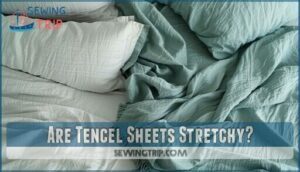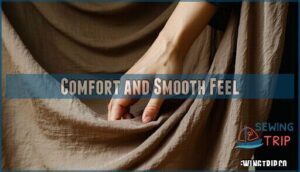This site is supported by our readers. We may earn a commission, at no cost to you, if you purchase through links.

Pure Tencel lyocell offers moderate natural flexibility—enough to move comfortably without feeling restricted, yet without the clingy compression of synthetic blends.
You’ll notice gentle give when you bend or reach, making it perfect for everyday clothing that needs to breathe with your body.
While it won’t stretch to extremes like spandex (which can extend 500% of its length), Tencel’s natural properties provide comfortable movement.
When blended with elastic fibers, it combines eco-friendly benefits with enhanced stretch performance for activewear and fitted garments.
Understanding how different fabric blends affect stretch properties can help you choose the right Tencel option, considering its comfortable movement and potential for enhanced stretch performance.
Table Of Contents
- Key Takeaways
- How Does Tencel Compare to Other Stretchy Fabrics?
- Is Tencel Stretchy in Jeans?
- Are Tencel Sheets Stretchy?
- Does Tencel Stretch as You Wear It?
- How to Stretch Tencel Fabric
- What Are The Benefits and Advantages of Tencel Fabric?
- What Are The Disadvantages of Tencel Fabric?
- Frequently Asked Questions (FAQs)
- Conclusion
Key Takeaways
- Pure Tencel offers minimal stretch – You’ll get only about 5% natural flexibility, which provides gentle give for comfortable movement but won’t stretch like spandex or elastane.
- Blended Tencel delivers enhanced stretch – When you choose Tencel mixed with elastane or spandex (typically 2-8%), you’ll enjoy significantly more flexibility while keeping Tencel’s eco-friendly benefits.
- Tencel maintains its shape better than cotton – You won’t experience the permanent stretching and sagging that cotton develops over time, as Tencel resists deformation and bounces back to its original form.
- Different applications require different stretch levels – You’ll find pure Tencel works well for breathable everyday wear, while Tencel blends are better for fitted garments, activewear, and deep-pocket bedding that needs flexibility.
How Does Tencel Compare to Other Stretchy Fabrics?
When you’re choosing between Tencel and other fabrics, understanding their stretch differences helps you pick the right material for your needs.
Pure Tencel offers minimal stretch at around 5%, while fabrics like elastane and spandex provide substantially more flexibility for activewear and form-fitting garments.
Comparison With Cotton
When comparing Tencel stretch to cotton, you’ll notice significant differences in fabric behavior and durability over time.
Tencel holds its shape while cotton loosens—understanding this difference helps you choose the right fabric for lasting comfort.
- Cotton provides more natural give – Cotton fibers have inherent stretch that increases with wear
- Tencel maintains shape better – Pure Tencel fabric resists stretching and sagging compared to cotton
- Water usage differs dramatically – Tencel production uses 99% less water than cotton farming
- Breathability varies by construction – Both offer good airflow, but Tencel excels in moisture-wicking performance
Tencel is also known for its superior moisture-wicking capabilities compared to cotton.
Comparison With Elastane
While tencel stretch reaches only 5%, elastane delivers up to 500% stretch with superior recovery.
Pure tencel maintains shape after gentle stretching, but elastane blend ratios of 3-8% dramatically boost stretch performance differences.
These elastic fibers create comfort level comparison advantages in activewear, balancing tencel’s breathability with elastane’s flexibility.
Elastane’s high elasticity allows it to stretch up to seven times its original length.
Durability and stretch improve together, though cost analysis shows blended fabrics cost more than pure tencel elasticity options.
Comparison With Linen
Unlike elastane’s rubber-like properties, linen offers zero stretch capabilities.
This natural fiber maintains rigid structure even when pulled, making tencel vs linen stretch comparison clear-cut. Linen’s durability comes from strong flax fibers, but this strength creates inflexibility. Tencel provides slight give while linen stays completely static.
- Linen Texture: Crisp, structured feel with no elasticity
- Linen Wrinkling: Creases easily, requires frequent ironing
- Linen Absorbency: Excellent moisture-wicking but stays stiff
- Linen Durability: Extremely strong, lasts decades with care
- Linen Cost: Generally less expensive than Tencel fabric
Comparison With Polyester
When comparing tencel fabric stretch to polyester, you’ll find key differences in flexibility and comfort.
Polyester lacks natural elasticity but gains stretch when blended with elastane. Tencel offers minimal stretch alone but excels in breathability where polyester traps heat.
Polyester durability surpasses tencel’s delicate nature, while polyester cost remains lower. However, polyester production creates environmental concerns unlike tencel’s sustainable manufacturing process.
Is Tencel Stretchy in Jeans?
Understanding jeans stretch factor starts with knowing that pure Tencel denim blend offers minimal natural elasticity. Without added stretch fibers, your Tencel jeans won’t give much when you move or sit.
Most manufacturers solve this by creating a Tencel denim blend with elastane or spandex. Here’s what you’ll typically find:
- 2-5% elastane content provides vertical stretch up to 20% while maintaining Tencel’s soft feel
- Shape retention stays strong throughout the day without sagging or losing form
- Comfort and fit improves dramatically compared to rigid 100% cotton denim
This combination creates denim alternatives that move with your body while keeping their flattering silhouette. The stretch resistance of Tencel fabric actually works in your favor here—it prevents the over-stretching that makes regular jeans baggy after wear. To enhance durability, consider options with polyester and spandex.
When shopping for Tencel jeans stretch, look for blends rather than pure lyocell if you want flexibility. Does lyocell stretch on its own? Not substantially, but blended properly, it creates some of the most comfortable denim you’ll wear.
Are Tencel Sheets Stretchy?
When shopping for bedsheets, you’ll quickly discover that pure Tencel sheets offer minimal stretch compared to other fabrics. Tencel’s wood pulp fibers naturally lack elasticity, providing only about 5% give in any direction.
This limited tencel stretching means the bedsheets won’t contour dramatically to your body or mattress curves. However, manufacturers have found clever solutions.
Sheet Blend Options include mixing Tencel with elastane or spandex, creating fabrics with substantially more flexibility. The Tencel Weave Impact also matters—knit constructions offer more stretch than traditional woven varieties, though knit Tencel sheets remain uncommon in bedding.
Tencel’s breathability is enhanced by its airy weave structure, making it ideal for bedding. Thread Count Effects play a role too. Higher thread counts create tighter weaves with less natural give.
For Sleeping Comfort Impact, this means pure Tencel prioritizes smoothness and breathability over stretchiness. When Bed Size Matters for deep mattresses, look for Tencel blends with elastic fibers to guarantee proper fit and coverage throughout the night.
| Fabric Type | Stretch Level | Best For |
|---|---|---|
| Pure Tencel | Minimal (5%) | Hot sleepers seeking breathability |
| Tencel + Elastane | Moderate (15-20%) | Active sleepers needing flexibility |
| Tencel + Spandex | High (25-30%) | Deep mattresses requiring stretch |
| Knit Tencel | Low-Moderate (8-12%) | Comfort-focused sleepers |
Does Tencel Stretch as You Wear It?
Your favorite cotton t-shirt gradually loosens with wear, but Tencel fabric behaves differently.
Pure Tencel has moderate stretch over time, adapting to your body through repeated wear and washing cycles.
Here’s how Tencel fabric stretch develops naturally:
- Body Heat Effects – Warmth softens fibers, allowing gradual fabric stretching around curves and pressure points
- Movement Patterns – Regular motion creates micro-adjustments in fiber alignment, enhancing stretch over time
- Washing Cycles – Gentle laundering relaxes fiber tension while maintaining Tencel shape retention properties
- Wearing Impacts Stretch – Consistent use encourages fabric conformity without causing long-term deformity
Unlike synthetic materials that snap back instantly, Tencel fiber weakening occurs gradually and permanently.
This natural adaptation means garments become more comfortable over months of regular wear.
The fabric’s inherent strength prevents excessive stretching while allowing enough give for improved fit.
Tencel clothing stretch remains controlled, avoiding the baggy appearance common with other natural fibers after extended use.
How to Stretch Tencel Fabric
Despite Tencel’s natural lack of elasticity, you can achieve some fabric stretching through gentle manipulation techniques. Pure Tencel fibers resist stretching, but wet stretching methods can provide temporary relief for snug garments.
Start with wet stretching by soaking your garment in lukewarm water until fully saturated. Apply gentle pulling to target areas like sleeves or waistbands, using even tension to avoid fiber damage. Heat application isn’t recommended as it can weaken Tencel’s structure. Instead, focus on fiber manipulation while damp.
Some retailers offer products designed for Tencel fabric care. You can feel the satisfaction of reviving a favorite garment that’s become too tight, and experience relief knowing you’ve extended your clothing’s lifespan sustainably.
- Enjoy the confidence that comes with a perfectly fitting outfit
- Appreciate the cost savings from avoiding premature replacements
After stretching, reshape the fabric on a flat surface and air dry completely. Remember that blending options with elastane create more permanent stretch solutions than mechanical stretching alone.
What Are The Benefits and Advantages of Tencel Fabric?
While Tencel mightn’t stretch much on its own, it offers impressive benefits that make it worth considering for your wardrobe and home.
You’ll discover that this sustainable fabric brings unique advantages in comfort, health, and performance that set it apart from traditional materials.
Comfort and Smooth Feel
Your skin will thank you for choosing Tencel’s luxurious feel and gentle touch.
This smooth surface fabric offers unmatched Tencel softness that’s perfect for skin sensitivity concerns.
The breathability and all-day comfort make it ideal for anyone seeking premium textiles.
Whether you’re dealing with tencel stretch garments or pure fabric, the comfort and softness remain consistently exceptional.
Antibacterial Properties
Beyond Tencel’s impressive comfort and smooth texture, the fabric offers remarkable antibacterial properties that protect your skin’s health.
Tencel antimicrobial qualities stem from its natural resistance to bacterial growth, creating a cleaner wearing experience throughout the day.
The fabric’s unique structure prevents harmful bacteria from thriving, while its exceptional breathability keeps moisture away from your skin.
This combination delivers significant hygiene benefits that you’ll notice immediately:
- Natural odor control that keeps clothes fresher longer
- Reduced bacterial buildup on fabric surfaces
- Enhanced skin health through cleaner contact surfaces
When you wear Tencel garments, you’re getting more than just stretch and comfort.
The fabric actively works to maintain a healthier environment against your skin, making it perfect for activewear, undergarments, and bedding where hygiene matters most.
Temperature Regulation
Tencel’s temperature-regulation prowess makes it a game-changer for hot weather comfort.
The fabric’s unique fiber structure creates natural breathability that outperforms traditional materials.
- Moisture-wicking efficiency – Absorbs 50% more moisture than cotton
- Enhanced airflow – Open fiber structure promotes ventilation and cooling properties
- Body temperature balance – Adapts to your skin’s needs for seasonal comfort
This moisture-wicking ability keeps you dry while Tencel stretch maintains comfort throughout movement.
What Are The Disadvantages of Tencel Fabric?
While Tencel offers impressive benefits, you’ll face some practical challenges when choosing this fabric.
Cost considerations top the list, as Tencel typically costs more than cotton or synthetic alternatives.
Limited availability means you can’t always find Tencel options in every store or style you want.
The fabric’s wrinkle-prone nature requires careful handling, especially compared to synthetic blends.
Tencel shrinkage can occur if you don’t follow proper care instructions, and the limited stretch means pure Tencel won’t give you the flexibility of elastane blends.
| Disadvantage | Impact | Solution |
|---|---|---|
| Pilling potential | Fabric surface becomes fuzzy | Gentle washing cycles |
| Fading colors | Garments lose vibrancy | Cold water, mild detergent |
| Higher cost | Budget constraints | Look for Tencel blends |
These drawbacks don’t make Tencel a poor choice, but understanding them helps you make informed decisions about when this fabric works best for your needs.
Frequently Asked Questions (FAQs)
Is Tencel lyocell stretchy?
Pure Tencel lyocell isn’t stretchy—it has only about 5% stretch naturally. You’ll find more flexibility when it’s blended with elastane or spandex, or when it’s knitted rather than woven.
Does Tencel shrink?
Machine washable Tencel offers excellent shrink resistance compared to cotton.
You’ll find minimal shrinkage when washing in cold water on gentle cycles.
High heat from dryers can cause some shrinkage, so hang drying works better.
Does Tencel have stretch?
Surprisingly stretchy? Not quite! You’ll find pure Tencel offers minimal stretch—around 5% in all directions. However, when blended with elastane or spandex, it becomes wonderfully flexible for comfortable, form-fitting wear.
Is Tencel a stretchy fabric?
You’ll find that natural Tencel fabric has minimal stretch—around 5% in all directions. However, when blended with elastane or spandex, it gains significant flexibility for comfortable wear.
What makes Tencel a good fit?
Tencel’s incredible shape retention makes it your perfect fit companion.
Unlike cotton that stretches out permanently, Tencel bounces back to its original form after wearing, maintaining consistent sizing and comfort throughout the day.
What does Tencel feel like?
When you touch Tencel, you’ll feel silky-soft fabric that’s surprisingly smooth and lightweight.
It drapes beautifully against your skin, offering cooling comfort that’s breathable yet substantial enough to feel luxurious and well-made.
Does Tencel stretch out over time?
Like a rubber band that gradually loses its snap, pure Tencel develops minimal mechanical stretch over time through repeated wear, but it won’t dramatically change shape like cotton jeans do.
Will Tencel shrink in the wash?
Proper washing prevents Tencel shrinkage. You’ll maintain fabric integrity by using cold water, gentle cycles, and avoiding high heat during drying. Following care instructions keeps your Tencel items fitting perfectly.
Is Tencel a high-end fabric?
Fashion royalty has embraced this premium fiber for good reason.
You’ll find Tencel in luxury brands like Stella McCartney and high-end activewear, commanding higher prices than cotton due to its superior properties and sustainable production.
Does Tencel shrink when washed frequently?
Tencel doesn’t shrink substantially when washed frequently if you follow proper care instructions. Wash in cold water, use gentle cycles, and avoid high heat to maintain its shape and size.
Conclusion
Understanding Tencel’s stretch is like learning a dance partner’s moves—it gives just enough flexibility to follow your body’s rhythm.
Now you know does tencel stretch depends on the fabric blend and intended use.
Pure Tencel offers moderate natural stretch for comfortable daily wear, while blended versions provide enhanced flexibility for activewear.
Whether you’re choosing sheets, jeans, or casual clothing, Tencel’s eco-friendly properties combined with its gentle give make it a smart choice for sustainable comfort.
- https://brydenapparel.com/tencel-fabric/
- https://www.amazingwarehouseinc.com/blogs/news/does-tencel-stretch
- https://learn.eartheasy.com/guides/tencel-clothing/
- https://vaughans.ca/blogs/journal/the-benefits-of-tencel
- https://carvedinblue.tencel.com/blog-post/alternative-stretch-fabrics-with-lenzing-tencel/













